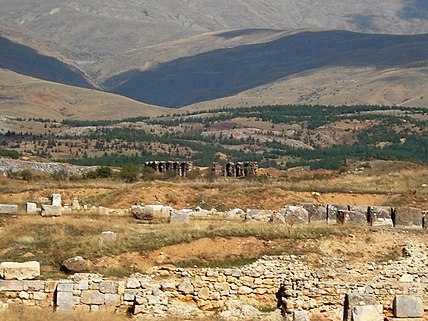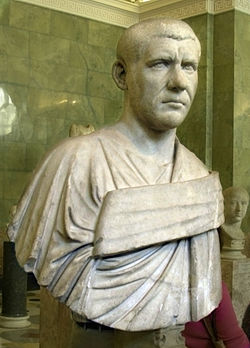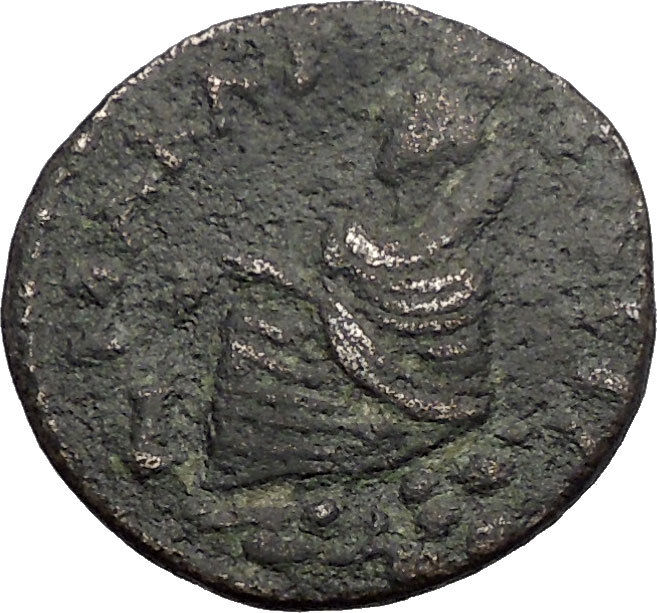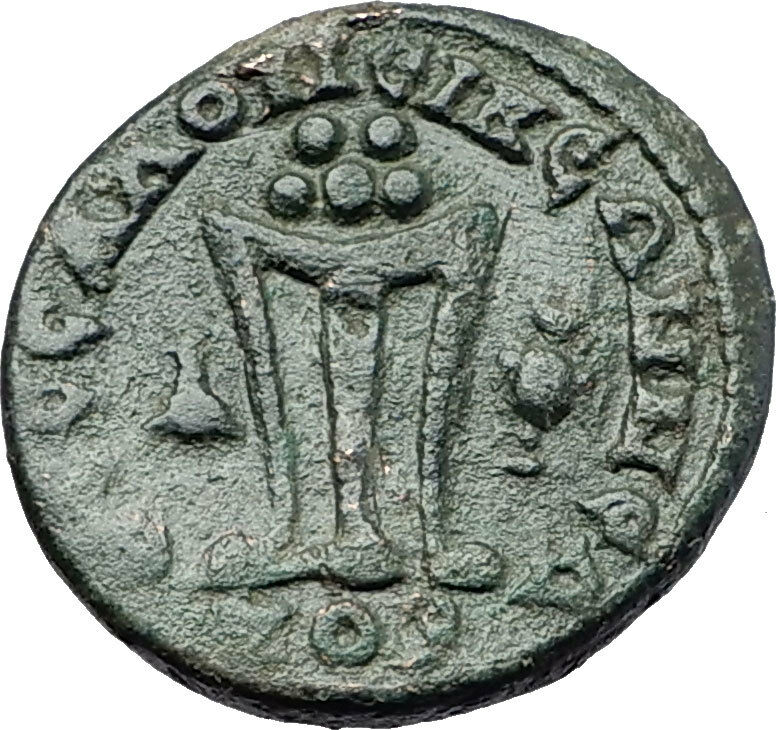|
Philip I ‘the Arab’ – Roman Emperor: 244-249 A.D.
Bronze 24mm (8.35 grams) of Antioch in Pisidia
Reference: SNG BN 1261-1262 var
IMP M IVL PHILIPPVS A, Radiate, draped and cuirassed bust right.
ANTIOCHI COLON around vexillum topped with eagle with S-R at shaft and flanked by two standards, each tipped with eagle.
You are bidding on the exact item pictured, provided with a Certificate of Authenticity and Lifetime Guarantee of Authenticity.
Standards
.jpg/400px-035_Conrad_Cichorius,_Die_Reliefs_der_Traianssäule,_Tafel_XXXV_(Ausschnitt_01).jpg) Roman military standards. The standards with discs, or signa (first three on left) belong to centuriae of the legion (the image does not show the heads of the standards – whether spear-head or wreathed-palm). Note (second from right) the legion’s aquila. The standard on the extreme right probably portrays the She-wolf (lupa) which fed Romulus, the legendary founder of Rome. (This was the emblem of Legio VI Ferrata, a legion then based in Judaea, a detachment of which is known to have fought in Dacia). Detail from Trajan’s Column, Rome Modern reenactors parade with replicas of various legionary standards. From left to right: signum (spear-head type), with four discs; signum (wreathed-palm type), with six discs; imago of ruling emperor; legionary aquila; vexillum of commander (legatus) of Legio XXX Ulpia Victrix, with embroidered name and emblem (Capricorn) of legion Roman military standards. The standards with discs, or signa (first three on left) belong to centuriae of the legion (the image does not show the heads of the standards – whether spear-head or wreathed-palm). Note (second from right) the legion’s aquila. The standard on the extreme right probably portrays the She-wolf (lupa) which fed Romulus, the legendary founder of Rome. (This was the emblem of Legio VI Ferrata, a legion then based in Judaea, a detachment of which is known to have fought in Dacia). Detail from Trajan’s Column, Rome Modern reenactors parade with replicas of various legionary standards. From left to right: signum (spear-head type), with four discs; signum (wreathed-palm type), with six discs; imago of ruling emperor; legionary aquila; vexillum of commander (legatus) of Legio XXX Ulpia Victrix, with embroidered name and emblem (Capricorn) of legion
 Each tactical unit in the imperial army, from centuria upwards, had its own standard. This consisted of a pole with a variety of adornments that was borne by dedicated standard-bearers who normally held the rank of duplicarius. Military standards had the practical use of communicating to unit members where the main body of the unit was situated, so that they would not be separated, in the same way that modern tour-group guides use umbrellas or flags. But military standards were also invested with a mystical quality, representing the divine spirit (genius) of the unit and were revered as such (soldiers frequently prayed before their standards). The loss of a unit’s standard to the enemy was considered a terrible stain on the unit’s honour, which could only be fully expunged by its recovery. Each tactical unit in the imperial army, from centuria upwards, had its own standard. This consisted of a pole with a variety of adornments that was borne by dedicated standard-bearers who normally held the rank of duplicarius. Military standards had the practical use of communicating to unit members where the main body of the unit was situated, so that they would not be separated, in the same way that modern tour-group guides use umbrellas or flags. But military standards were also invested with a mystical quality, representing the divine spirit (genius) of the unit and were revered as such (soldiers frequently prayed before their standards). The loss of a unit’s standard to the enemy was considered a terrible stain on the unit’s honour, which could only be fully expunged by its recovery.
The standard of a centuria was known as a signum, which was borne by the unit’s signifer. It consisted of a pole topped by either an open palm of a human hand or by a spear-head. The open palm, it has been suggested, originated as a symbol of the maniple (manipulus=”handful”), the smallest tactical unit in the Roman army of the mid-Republic. The poles were adorned with two to six silver discs (the significance of which is uncertain). In addition, the pole would be adorned by a variety of cross-pieces (including, at bottom, a crescent-moon symbol and a tassel). The standard would also normally sport a cross-bar with tassels.
The standard of a Praetorian cohort or an auxiliary cohort or ala was known as a vexillum or banner. This was a square flag, normally red in colour, hanging from a crossbar on the top of the pole. Stitched on the flag would be the name of the unit and/or an image of a god. An exemplar found in Egypt bears an image of the goddess Victory on a red background. The vexillum was borne by a vexillarius. A legionary detachment (vexillatio) would also have its own vexillum. Finally, a vexillum traditionally marked the commander’s position on the battlefield.[194] The exception to the red colour appears to have been the Praetorian Guard, whose vexilla, similar to their clothing, favoured a blue background.
From the time of Marius (consul 107 BC), the standard of all legions was the aquila (“eagle”). The pole was surmounted by a sculpted eagle of solid gold, or at least gold-plated silver, carrying thunderbolts in its claws (representing Jupiter, the highest Roman god. Otherwise the pole was unadorned. No exemplar of a legionary eagle has ever been found (doubtless because any found in later centuries were melted down for their gold content). The eagle was borne by the aquilifer, the legion’s most senior standard-bearer. So important were legionary eagles as symbols of Roman military prestige and power, that the imperial government would go to extraordinary lengths to recover those captured by the enemy. This would include launching full-scale invasions of the enemy’s territory, sometimes decades after the eagles had been lost e.g. the expedition in 28 BC by Marcus Licinius Crassus against Genucla (Isaccea, near modern Tulcea, Rom., in the Danube delta region), a fortress of the Getae, to recover standards lost 33 years earlier by Gaius Antonius, an earlier proconsul of Macedonia. Or the campaigns of AD 14-17 to recover the three eagles lost by Varus in AD 6 in the Teutoburg Forest.
Under Augustus, it became the practice for legions to carry portraits (imagines) of the ruling emperor and his immediate family members. An imago was usually a bronze bust carried on top of a pole like a standard by an imaginifer.
From around the time of Hadrian (r. 117-38), some auxiliary alae adopted the dragon-standard (draco) commonly carried by Sarmatian cavalry squadrons. This was a long cloth wind-sock attached to an ornate sculpture of an open dragon’s mouth. When the bearer (draconarius) was galloping, it would make a strong hissing-sound.
Decorations
The Roman army awarded a variety of individual decorations (dona) for valour to its legionaries. Hasta pura was a miniature spear; phalerae were large medal-like bronze or silver discs worn on the cuirass; armillae were bracelets worn on the wrist; and torques were worn round the neck, or on the cuirass. The highest awards were the coronae (“crowns”), of which the most prestigious was the corona civica, a crown made oak-leaves awarded for saving the life of a fellow Roman citizen in battle. The most valuable award was the corona muralis, a crown made of gold awarded to the first man to scale an enemy rampart. This was awarded rarely, as such a man hardly ever survived.
There is no evidence that auxiliary common soldiers received individual decorations like legionaries, although auxiliary officers did. Instead, the whole regiment was honoured by a title reflecting the type of award e.g. torquata (“awarded a torque”) or armillata (“awarded bracelets”). Some regiments would, in the course of time, accumulate a long list of titles and decorations e.g. cohors I Brittonum Ulpia torquata pia fidelis c.R..
 Antioch in Pisidia – alternatively Antiochia in Pisidia or Pisidian Antioch and in Roman Empire, Latin: Antiochia Caesareia or Antiochia Caesarea – is a city in the Turkish Lakes Region, which is at the crossroads of the Mediterranean, Aegean and Central Anatolian regions, and formerly on the border of Pisidia and Phrygia, hence also known as Antiochia in Phrygia. The site lies approximately 1 km northeast of Yalvaç, the modern town of Isparta Province. The city is on a hill with its highest point of 1236 m in the north. Antioch in Pisidia – alternatively Antiochia in Pisidia or Pisidian Antioch and in Roman Empire, Latin: Antiochia Caesareia or Antiochia Caesarea – is a city in the Turkish Lakes Region, which is at the crossroads of the Mediterranean, Aegean and Central Anatolian regions, and formerly on the border of Pisidia and Phrygia, hence also known as Antiochia in Phrygia. The site lies approximately 1 km northeast of Yalvaç, the modern town of Isparta Province. The city is on a hill with its highest point of 1236 m in the north.
While the Hellenistic Kingdoms (the inheritors of Alexander the Great) were fighting each other and the Galatians, Rome became the most powerful state in Europe and started to follow a policy of expansion to the east. They invaded Macedon, Thrace, and the Dardanelles, and reaching Phrygia via Magnesia and Pisidia. They cowed the Galatians and according to the treaty signed in Apamea in 188 BC, they gave the land of Pisidia which they had got from Antiochos III, to their ally the Pergamon Kingdom which dominated the region. Attalos III, the last king of Pergamon, bequeathed his kingdom to Rome on his death in 133 BC Aristonikos who claimed Pergamon was defeated in 129, then Rome affected Anatolia with its well-developed, creative culture for centuries.
Although Anatolia was dominated by the Roman Empire as the province of Asia, Pisidia was given to the Kingdom of Cappadocia, which was an ally of Rome. During the following years, the authority gap which could not be filled by these kingdoms remote from central government, led to the rise of powerful pirate kingdoms, especially in Cilicia and Pisidia. The Romans were disturbed by these kingdoms and fought against them. Cilicia, Pamphylia, Phrygia and Pisida were freed from pirates and Roman rule was restored in 102 BC.
The geographical and strategical position of the region made it difficult to control the area and maintain constant peace. The Homonadesians, settled in the Taurus Mountains between Attaleia and Ikonion, caused problems for Rome. Marcus Antonius who had to control the roads connecting Pisidia to Pamphylia, charged his allied king Amyntas, King of Pisidia, to fight against Homonadesians, but Amyntas was killed during the struggle.
Then Rome started to colonize using military legions as a solution to the failure of the locally appointed governors. The Province of Galatia was established in 25 BC and Antioch became a part of it. To support the struggle against the Homonadesians logistically, the construction of a road called the Via Sebaste, the centre of which was Antioch, was started by the governor of the Province of Galatia, Cornutus Arrutius Aquila. The Via Sebaste was separated into two and directed to the southwest and southeast to surround the Homonadesians. Secondary connecting roads were built between these two roads. Rome by means of the Via Sebaste P.Sulpicius Quirinius brought an end to the Homonadesians problem in 3 BC, relocating survivors in different surrounding locations.
During the reign of Augustus, eight colonies were established in Pisidia, but only Antioch was honoured with the title of Caesarea and given the right of the Ius Italicum, maybe because of its strategic position. The city became an important Roman colony which rose to the position of a capital city with the name of “Colonia Caesarea“.
Hellenisation became Latinisation during the Roman period and it was applied in Antioch best. The city was divided into seven quarters called “vici” all of which were founded on seven hills like in Rome. The formal language was Latin until the end of the 3rd century. The fertility of the land and the peace brought by Augustus (Pax Romana: Roman Peace) made it easier for the veterans as colonists in the area to have good relations and integration with the natives.
One of the three surviving copies of the Res Gestae Divi Augusti, the famous inscription recording the noble deeds of the Emperor Augustus was found in front of the Augusteum in Antioch. The original was carved on bronze tablets and exhibited in front of the Mausoleum of Augustus in Rome, but unfortunately has not survived. The Antioch copy on stone was written in Latin which is a sign of the importance of the city as a military and cultural base of Rome in Asia. (One of the copies, in Greek and Latin, is in Ankara, the other, in Greek, in Apollonia -Uluborlu).
 Philip I ‘the Arab’ – Emperor: 244-249 A.D. Philip I ‘the Arab’ – Emperor: 244-249 A.D.
Augustus: 244-249 A.D. | 244-247 A.D. (Sole Reign) | 247-249 A.D. (with Philip II) |
| Husband of Otacilia Severa | Father of Philip II | Son of Julius Marinus |
Marcus Julius Philippus or Philippus I Arabs (c. 204-249), known in English as Philip the Arab or formerly (prior to World War II) in English as Philip the Arabian, was a Roman Emperor from 244 to 249.
Little is known about Philip’s early life and political career. He was born in Shahba, about 55 miles southeast of Damascus, in the Roman province of Syria. Philip has the nickname “the Arab” because he had family who had originated in the Arabian peninsula, believed to be distant descendants of the prestigious Baleed family of Aleppo. Philip was the son of a Julius Marinus, a local Roman citizen, possibly of some importance. Many historians agree that he was of Arab descent who gained Roman citizenship through his father, a man of considerable influence. Many citizens from the provinces took Roman names upon acquiring citizenship. This makes tracing his Arabic blood line difficult. However, it is documented that Rome used the Ghassan tribe from the Azd of Yemen as vassals to keep the neighboring northern Arabs in check.
The name of Philip’s mother is unknown, but sources refer to a brother, Gaius Julius Priscus, a member of the Praetorian guard under Gordian III (238-244). In 234, Philip married Marcia Otacilia Severa, daughter of a Roman Governor. They had two children: a son named Marcus Julius Philippus Severus (Philippus II) in 238 and according to numismatic evidence they had a daughter called Julia Severa or Severina, whom the ancient Roman sources don’t mention.
Philip became a member of the Pretorian Guard during the reign of the emperor Alexander Severus, who was a Syrian. In ancient Rome the Pretorian Guard was closely associated with the emperor, serving among other things as the emperor’s bodyguard.
In 243, during Gordian III’s campaign against Shapur I of Persia, the Praetorian prefect Timesitheus died under unclear circumstances. At the suggestion of his brother Priscus, Philip became the new Praetorian prefect, with the intention that the two brothers would control the young Emperor and rule the Roman world as unofficial regents. Following a military defeat, Gordian III died in 244 under circumstances that are still debated. While some claim that Philip conspired in his murder, other accounts (including one coming from the Persian point of view) state that Gordian died in battle. Whatever the case, Philip assumed the purple following Gordian’s death. According to Edward Gibbon:
His rise from so obscure a station to the first dignities of the empire seems to prove that he was a bold and able leader. But his boldness prompted him to aspire to the throne, and his abilities were employed to supplant, not to serve, his indulgent master.
Philip was not willing to repeat the mistakes of previous claimants, and was aware that he had to return to Rome in order to secure his position with the senate. He thus travelled west, after concluding a peace treaty with Shapur I, and left his brother Priscus as extraordinary ruler of the Eastern provinces. In Rome he was confirmed Augustus, and nominated his young son Caesar and heir.
Philip’s rule started with yet another Germanic incursion on the provinces of Pannonia and the Goths invaded Moesia (modern-day Serbia and Bulgaria) in the Danube frontier. They were finally defeated in the year 248, but the legions were not satisfied with the result, probably due to a low share of the plunder, if any. Rebellion soon arose and Tiberius Claudius Pacatianus was proclaimed emperor by the troops. The uprising was crushed and Philip nominated Gaius Messius Quintus Decius as governor of the province. Future events would prove this to be a mistake. Pacatianus’ revolt was not the only threat to his rule: in the East, Marcus Jotapianus led another uprising in response to the oppressive rule of Priscus and the excessive taxation of the Eastern provinces. Two other usurpers, Marcus Silbannacus and Sponsianus, are reported to have started rebellions without much success.
In April A.D. 248 (April 1000 A.U.C.), Philip had the honour of leading the celebrations of the one thousandth birthday of Rome, which according to tradition was founded in 753 BC by Romulus. He combined the anniversary with the celebration of Rome’s alleged tenth saeculum. According to contemporary accounts, the festivities were magnificent and included spectacular games, ludi saeculares, and theatrical presentations throughout the city. In the coliseum, more than 1,000 gladiators were killed along with hundreds of exotic animals including hippos, leopards, lions, giraffes, and one rhinoceros. The events were also celebrated in literature, with several publications, including Asinius Quadratus’s History of a Thousand Years, specially prepared for the anniversary.
Despite the festive atmosphere, discontent in the legions was growing. Decius (249-251) was proclaimed Emperor by the Danubian armies in the spring of 249 and immediately marched to Rome. Philip’s army met the usurper near modern Verona that summer. Decius won the battle and Philip was killed sometime in September 249, either in the fighting or assassinated by his own soldiers who were eager to please the new ruler. Philip’s eleven-year-old son and heir may have been killed with his father and Priscus disappeared without a trace.
Some later traditions, first mentioned in the historian Eusebius in his Ecclesiastical History, held that Philip was the first Christian Roman emperor. This tradition seems to be based on reports in Eusebius that Philip allegedly had once entered a Christian service on Easter, after having been required by a bishop to confess his sins. Later versions located this event in Antioch.
However, historians generally identify the later Emperor Constantine, baptised on his deathbed, as the first Christian emperor, and generally describe Philip’s adherence to Christianity as dubious, because non-Christian writers do not mention the fact, and because throughout his reign, Philip to all appearances (coinage, etc.) continued to follow the state religion. Critics ascribe Eusebius’ claim as probably due to the tolerance Philip showed towards Christians. Saint Quirinus of Rome was, according to a legendary account, the son of Philip the Arab.
|





.jpg/400px-035_Conrad_Cichorius,_Die_Reliefs_der_Traianssäule,_Tafel_XXXV_(Ausschnitt_01).jpg) Roman military standards. The standards with discs, or signa (first three on left) belong to centuriae of the legion (the image does not show the heads of the standards – whether spear-head or wreathed-palm). Note (second from right) the legion’s aquila. The standard on the extreme right probably portrays the She-wolf (lupa) which fed Romulus, the legendary founder of Rome. (This was the emblem of Legio VI Ferrata, a legion then based in Judaea, a detachment of which is known to have fought in Dacia). Detail from Trajan’s Column, Rome Modern reenactors parade with replicas of various legionary standards. From left to right: signum (spear-head type), with four discs; signum (wreathed-palm type), with six discs; imago of ruling emperor; legionary aquila; vexillum of commander (legatus) of Legio XXX Ulpia Victrix, with embroidered name and emblem (Capricorn) of legion
Roman military standards. The standards with discs, or signa (first three on left) belong to centuriae of the legion (the image does not show the heads of the standards – whether spear-head or wreathed-palm). Note (second from right) the legion’s aquila. The standard on the extreme right probably portrays the She-wolf (lupa) which fed Romulus, the legendary founder of Rome. (This was the emblem of Legio VI Ferrata, a legion then based in Judaea, a detachment of which is known to have fought in Dacia). Detail from Trajan’s Column, Rome Modern reenactors parade with replicas of various legionary standards. From left to right: signum (spear-head type), with four discs; signum (wreathed-palm type), with six discs; imago of ruling emperor; legionary aquila; vexillum of commander (legatus) of Legio XXX Ulpia Victrix, with embroidered name and emblem (Capricorn) of legion  Each tactical unit in the imperial army, from centuria upwards, had its own standard. This consisted of a pole with a variety of adornments that was borne by dedicated standard-bearers who normally held the rank of duplicarius. Military standards had the practical use of communicating to unit members where the main body of the unit was situated, so that they would not be separated, in the same way that modern tour-group guides use umbrellas or flags. But military standards were also invested with a mystical quality, representing the divine spirit (genius) of the unit and were revered as such (soldiers frequently prayed before their standards). The loss of a unit’s standard to the enemy was considered a terrible stain on the unit’s honour, which could only be fully expunged by its recovery.
Each tactical unit in the imperial army, from centuria upwards, had its own standard. This consisted of a pole with a variety of adornments that was borne by dedicated standard-bearers who normally held the rank of duplicarius. Military standards had the practical use of communicating to unit members where the main body of the unit was situated, so that they would not be separated, in the same way that modern tour-group guides use umbrellas or flags. But military standards were also invested with a mystical quality, representing the divine spirit (genius) of the unit and were revered as such (soldiers frequently prayed before their standards). The loss of a unit’s standard to the enemy was considered a terrible stain on the unit’s honour, which could only be fully expunged by its recovery. Antioch in Pisidia – alternatively Antiochia in Pisidia or Pisidian Antioch and in Roman Empire, Latin: Antiochia Caesareia or Antiochia Caesarea – is a city in the Turkish Lakes Region, which is at the crossroads of the Mediterranean, Aegean and Central Anatolian regions, and formerly on the border of Pisidia and Phrygia, hence also known as Antiochia in Phrygia. The site lies approximately 1 km northeast of Yalvaç, the modern town of Isparta Province. The city is on a hill with its highest point of 1236 m in the north.
Antioch in Pisidia – alternatively Antiochia in Pisidia or Pisidian Antioch and in Roman Empire, Latin: Antiochia Caesareia or Antiochia Caesarea – is a city in the Turkish Lakes Region, which is at the crossroads of the Mediterranean, Aegean and Central Anatolian regions, and formerly on the border of Pisidia and Phrygia, hence also known as Antiochia in Phrygia. The site lies approximately 1 km northeast of Yalvaç, the modern town of Isparta Province. The city is on a hill with its highest point of 1236 m in the north. Philip I ‘the Arab’ – Emperor: 244-249 A.D.
Philip I ‘the Arab’ – Emperor: 244-249 A.D.




